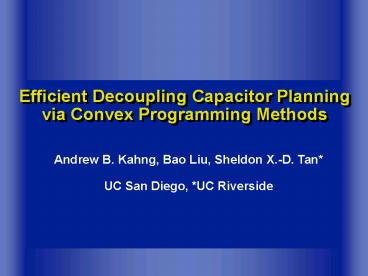Efficient Decoupling Capacitor Planning via Convex Programming Methods PowerPoint PPT Presentation
1 / 24
Title: Efficient Decoupling Capacitor Planning via Convex Programming Methods
1
Efficient Decoupling Capacitor Planning via
Convex Programming Methods
Andrew B. Kahng, Bao Liu, Sheldon X.-D. Tan UC
San Diego, UC Riverside
2
Outline
- Background
- Problem Formulation
- Semi-Definite Program
- Linear Program
- Scalability Enhancement
- Experiments
- Conclusion
3
P/G Supply Voltage Integrity
- Increasing Power/Ground supply voltage
degradation in latest technologies due to
increasing - Interconnect resistance
- Supply current density
- Clock frequency
- Degraded power/ground supply voltages and
relatively stable transistor threshold voltage
leaves a decreased noise margin and increased
vulnerability to logic malfunction - Degraded P/G supply voltages degrades transistor
and circuit performance
4
P/G Network Optimization
- Supply voltage degradation includes
- DC IR drop
- AC IR drop
- L dI/dt drop
- P/G network optimization techniques include
- Wire-sizing
- Edge augmentation
- Decoupling capacitor insertion
5
Decoupling Capacitors
- Are usually CMOS capacitors
- Form charge reservoirs ? provide short-cuts for
supply currents ? reduce supply voltage
degradation - Form low pass filters ? remove high frequency
components in supply currents and cancel
inductance effect ? reduce supply voltage
degradation
6
Decoupling Capacitor Insertion
- q heuristic
- Supply noise charge x a scaling factor
- Sensitivity analysis greedy optimization
- A mxn Jacobian matrix for m violation nodes and n
decoupling capacitor nodes - Adjoint sensitivity analysis iterative
quadratic optimization - Adjoint network for each supply current sources
contribution - Time domain integral of supply voltage drop
- Remains a nonlinear optimization problem
7
Outline
- Background
- Problem Formulation
- Semi-Definite Program
- Linear Program
- Scalability Enhancement
- Experiments
- Conclusion
8
Modified Nodal Analysis
- (GsC)V BuJ
- V free node voltages
- u reference node voltage
- B conductance between free nodes and the
reference node - J free node supply currents
- C ground capacitance matrix
- G conductance matrix
- Gij conductance between two free nodes i and j
- Gii Sj?i Gij Bi
9
Problem Formulation
- Given
- an RLC P/G supply network G
- free node supply currents J
- maximum supply current duration time T
- supply voltage degradation bound aVdd
- Find
- minimum decoupling capacitance Si Cii such that
DVi(t) lt aVdd for all i in G, t lt T
10
Duality of Timing and Voltage Bounds
time
voltage
lower bounding delay
upper bounding voltage drop
11
Semi-Definite Program
- For timing optimization
- Minimize t
- Subject to t G C ? 0
- M t G C is positive semi-definite ? xT M x ?
0 ? x - t needs to be larger than the eigenvalues of
G-1C, e.g., RC time constants of the interconnect
12
Semi-Definite Program
- For supply voltage optimization
- Minimize Si Cii
- Subject to C T G ? 0
- M C T G is positive semi-definite ? xT M x ?
0 ? x - T needs to be smaller than the eigenvalues of
G-1C, e.g., RC time constants of the interconnect - Loose bound ? relaxation to a convex super-space
13
Linear Program
- Provides tighter bounds by considering
differences in - Node voltage bounds
- Supply currents
- Residues of poles
- Upper bounds supply current waveforms by step
functions - Upper bounds 50 interconnect delay by Elmore
delay
14
Moment Computation
15
Linear Program Decap Insertion
- Minimize
- Subject to
- or
- For a node which DC voltage is within the bound,
e.g., ,
gives 0 right-hand side - Physical constraints
- Inductance effect
16
Numerical Example
- Semi-definite Program
- with eigenvalues 1,6 larger than 1(ns)
17
Numerical Example
- Linear Program
- Given
- Minimize
- Subject to
- ?
optimum c31/lg2
18
Numerical Example
- q heuristic is optimistic
- SDP is pessimistic
- LP gives accurate solution
19
Scalability Enhancement
- Reduce a P/G network to include only possible
decoupling capacitor insertion nodes - In the original P/G network
- In the reduced P/G network
- Apply unit supply current and compute node
voltages - Solve a linear equation system and find
equivalent supply currents for the decap
insertion nodes
20
Scalable Decap Insertion Linear Program
- Input RLC P/G network G, supply currents J
- during time T, voltage bound aVdd
- Output inserted decoupling capacitors
- Select n decap insertion candidate nodes
- Reduce G to include only the n decap insertion
nodes - Apply linear program
- Insert decoupling capacitors
21
Outline
- Background
- Problem Formulation
- Semi-definite Program
- Linear Program
- Scalability Enhancement
- Experiments
- Conclusion
22
Experiments
- 90nm industry design of 34K instances
- Cadence FireIce extracts a power network of 65K
resistors and 35K capacitors - VerilogXL outputs supply currents of 5.613A in
total - T 1ns, a 0.2
- 16 decap insertion candidate nodes
- 16 SPICE DC simulation, each takes 1.15 seconds
23
Summary
- We propose a compact modified nodal analysis
formula for a P/G network - We apply timing optimization techniques for
supply voltage bound - We propose a semi-definite program, which
guarantees supply voltage bound for all supply
currents - We propose a linear program, which accurately
bounds supply voltage for given supply currents - We propose a P/G network reduction scheme for
scalability enhancement
24
Thank you !

